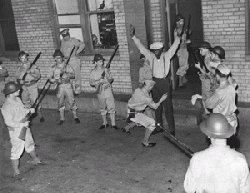NEW YORK — Activists are continuing to urge the National September 11 Memorial Museum at the World Trade Center to acknowledge “Little Syria” in its permanent exhibition.
Throughout the late 1880s, up until the 1940s, the area around the World Trade Center was known for having a vibrant and growing Arab American community. “Little Syria” was located around Washington Street in lower Manhatten. The entreprenuerial spirit of Arab immigrants in the neighborhood was once evident through the thriving small businesses that lined the streets and featured signs written in Arabic.
Much of the neighborhood was demolished to make room for the Brooklyn-Battery Tunnel and later the World Trade Center.

|
| Photos of “Little Syria” showing the everyday life of Syrian Americans living in New York. |
Today all that is left of “Little Syria” is a community center, a church and a tenement building. Groups across the country have expressed concern to Museum officials over recent years about getting the Museum to incorporate “Little Syria,” in addition to getting the New York City Landmarks Preservation Commission to designate all three remaining sites into a historical district.
Todd Fine and Carl Houck, the co-founders of Save Washington Street, a national coalition of organizations and individuals advocating the preservation of the last remaining traces of the Washington Street neighborhood of the lower west side say that, based on their understanding, the Museum had decided several years ago that it would include the history of life at the World Trade Center, issues associated with its construction, some references to the immediate neighborhood, and various objects found in the rubble in the surrounding area.
“All of these subjects touch the ‘Little Syria’ domain, and we have been specifically told that the contemporaneous ‘Radio Row’ will be included in the exhibit,” Fine said.
“Radio Row” was a warehouse district on the Lower West Side of Manhattan.
“I think if you are going to mention ‘Radio Row,’ you have to mention the whole thing,” said Ann Dinapoli, a member of Friends of the Lower West Side, a group that works to preserve the area’s history.
Fine says he raised concern over the issue with Museum officials in 2012 and met with them in January of this year.
A vast majority of “Little Syria” was comprised of Lebanese and Syrian immigrants, mostly Christian, along with a few Muslims. The neighborhood was reportedly home to one of the first Arabic printing presses.
In a letter to the Museum’s director Alice Greenwald and CEO Joe Daniels, an official from the American-Arab Anti-Discrimination Committee’s National Office says that the absence of “Little Syria” could be seen as discriminatory.
Since 9/11, there’s been an increase in hate crimes against Arab and Muslim Americans, and members of both communities have experienced marginalization.
Many say it is important for Arab Americans, who remain targets of discrimination, to know that the location is part of their heritage as well. Anthony Guido, a spokesman for the Museum, told The Arab American News it was no longer speaking on the record about the issue. Guido said, “On the issue of what goes into our permanent exhibition, it is narrowly focused directly on our mission.”
According to the Museum’s site, its mission is to bear solemn witness to the terrorist attacks of September 11, 2001 and February 1993 when a truck bomb was detonated below the north tower of the World Trade Center. The Museum honors nearly 3,000 victims of these attacks, along with all those who risked their lives to save others. It further recognizes the thousands who survived, and all those who demonstrated extraordinary compassion in the aftermath.
Esther Regelson, also a member of “Friends of the Lower West Side,” and Dinapoli met with one of the Museum’s exhibition researchers. “We got the impression that there was not enough room to do anything,” Dinapoli said.
Regelson says that while the meeting was very positive, the researcher noted that they had a lot to cover, and very little time to do it, and they would try and do what they could.
“I find it rather frustrating that there is no mention of lost history,” Regelson said. Both say that the neighborhood was also home to different ethnic groups, aside from Arab Americans, and it’s important to preserve their heritage as well.
Waves of immigrants, who came from different countries, are a part of New York City’s rich diverse history and have left their mark on some of the City’s most popular attractions, such as China Town and Little Italy. Activists say that the history of Arab Americans in the City should also be preserved in the same way various other ethnic groups’ heritage is.






Leave a Reply